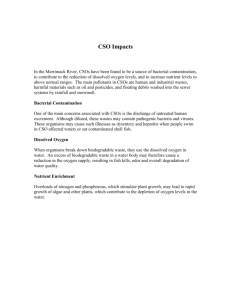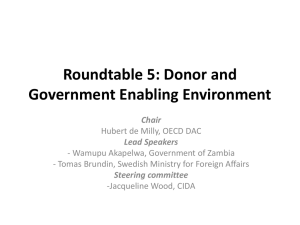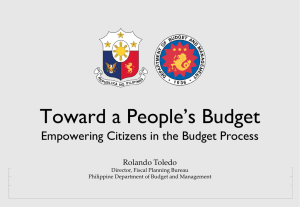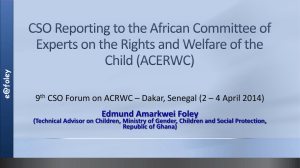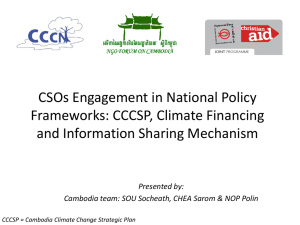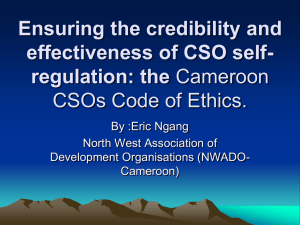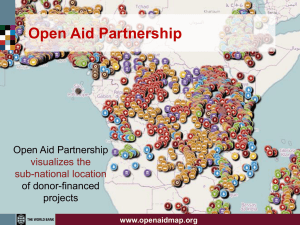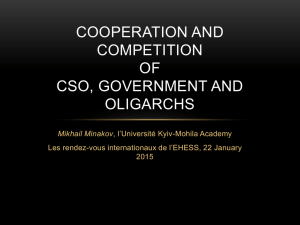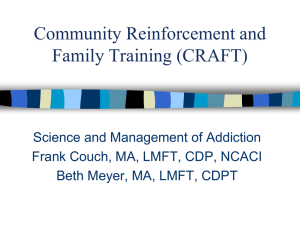Challenges and lessons learnt - HIV Capacity Building Partners Summit
advertisement
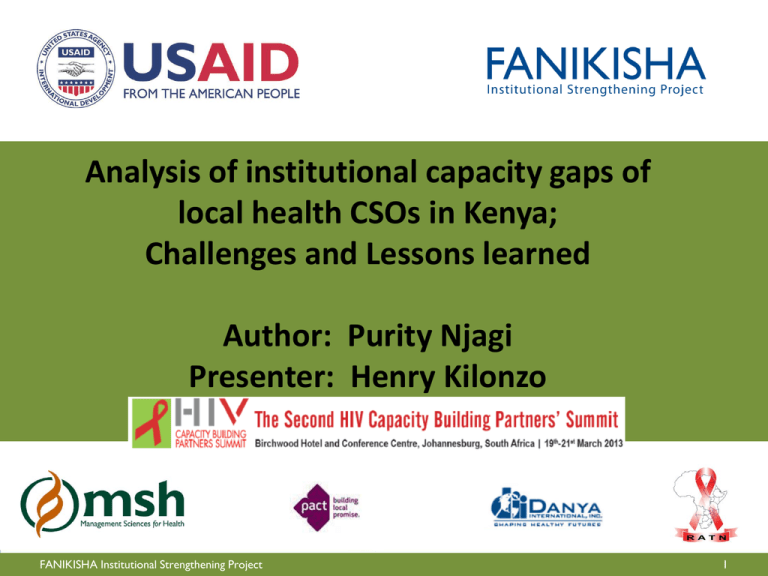
Analysis of institutional capacity gaps of local health CSOs in Kenya; Challenges and Lessons learned Author: Purity Njagi Presenter: Henry Kilonzo FANIKISHA Institutional Strengthening Project 1 Back ground Goal: Sustained improvement in the health and well-being of all Kenyans • Aim: to ensure and sustain CSO contribution in the health sector • Target: 10 national-level CSOs and their affiliates Expected results; Strengthen leadership, management, and governance of CSOs Increase access and use of quality data for evidencebased decision making Improve quality of institutional strengthening for CSOs • FANIKISHA Institutional Strengthening Project 2 Description of context • The growth of CSOs in Kenya has been very rapid • A significant proportion of community health grants have been channeled through international CSOs • Why international NGOs? • Capacity of the local CSOs remains low • • Weak national coordination and regulation structures for CSOs Organisational capacity is a key eligibility criterion for funding to local CSOs. FANIKISHA Institutional Strengthening Project 3 Approaches adopted FANIKISHA Institutional Strengthening Project 4 Methodology used; FANIKISHA Institutional Strengthening Project 5 Click to edit CSO Scoring Matrix title style Master Score Level Definition Score 1: The CSO does not have the relevant tool and/or function in this subcategory Score 2: The CSO has a tool and/or function but does not meet the desired quality or it is incomplete – whether applied or not Score 3: The CSO has the desired tool or function, is complete, is of good quality but is not applied at all or consistently to support the CSO institutional processes. Score 4: The CSO has a tool or function, is complete, is of good quality and is applied consistently to carry out the CSO institutional processes. This is the desired standard for the subcategory FANIKISHA Institutional Strengthening Project 6 Findings • The assessment revealed critical capacity gaps that require strengthening • Institutional strength varied amongst CSOs and across the 10 capacity categories. • Seven CSOs demonstrated overall satisfactory capacity, while six CSOs demonstrated low capacity. • Grant management emerged as the weakest; where all CSOs scored 1 or 2. FANIKISHA Institutional Strengthening Project 7 Challenges and counter-strategies employed Challenges Counter strategies CSOs perception on capacity assessments as a selection criteria Held pre- assessment meeting to manage expectations and clarify objectives of the Assessment Divergent views between staff and management on capacity status FANIKISHA technical advisors were present to provide technical guidance on the expected standard CSOs overrating their capacity Onsite review of documents and systems provided tangible evidence to guide on the actual gaps Lack of disclosure in presence of Assurance to all participants of the need key stakeholders. for confidentially on the process and any information disclosed FANIKISHA Institutional Strengthening Project 8 Evidence of success and achievements • Accelerated performance by CSOs, as some commenced implementation of the OCA recommendations prior to award “This process has been a great learning for us. …………………….. ……..which has been very comprehensive all the way from systems assessment and the final discussions on our organization’s capacity. Even if we are not selected to partner with FANIKISHA, we will definitely address the gaps that you have helped us identify.” -- Wilfred Owuor, CEO of Omega Foundation, Kisumu FANIKISHA Institutional Strengthening Project “This is an honest evaluation. We have heard comments in the past from members saying NEPHAK does not have adequate capacity. Now we have the confirmation. We will work to fill the gaps identified and also move this to our constituent community levels.” ---Rahab Mwaniki, Resource Mobilization Manager, NEPHAK “After we concluded the organizational capacity assessment with FANIKISHA, we immediately developed a resource mobilization strategy, which is one of the key gaps that we identified during the process.” Philip Waweru, Executive Director, National Organization of Peer Educators (NOPE) 9 Lessons learnt • Engaging and participation of stakeholders ensured objectivity in the assessment • Leveraged resources as stakeholders were made aware of existing capacity • The approach stimulated reflection, learning, and dialogue among CSO staff • The approach ensures gaps and opportunities are examined, and ideas for addressing them generated real time. FANIKISHA Institutional Strengthening Project 10 Conclusion • The OCA was a participatory tool designed to assist CSOs to identify their strengths, weaknesses and institutional strengthening needs • The participatory approach stimulated ownership of the findings by all (staff, management and board) • The approach has facilitated positive uptake of technical assistance and mentorship to CSOs. FANIKISHA Institutional Strengthening Project 11 Enabling Kenyan Civil Society Organizations for Lasting Health Impact Funding was provided by the United States President’s Emergency Plan for AIDS Relief (PEPFAR) and the United States Agency for International Development (USAID) under Cooperative Agreement AID-623-A-11-00029. FANIKISHA Institutional Strengthening Project 12
